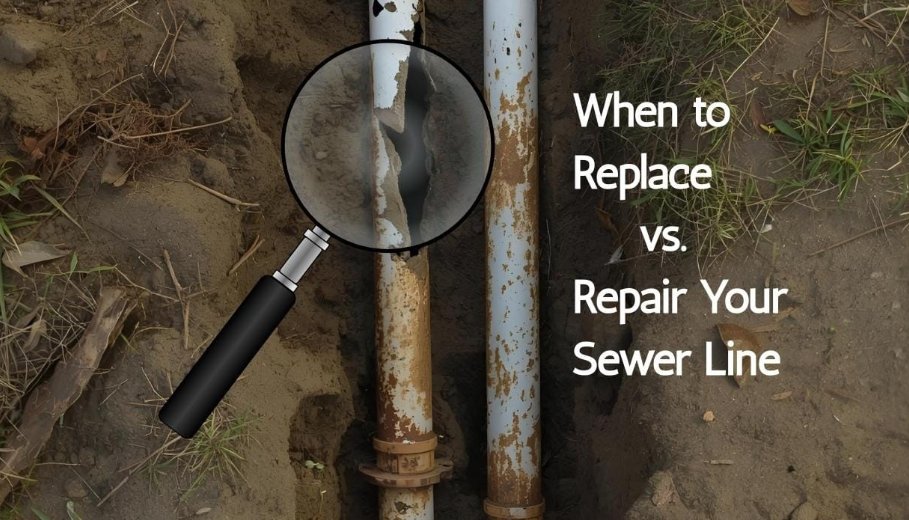A question that every homeowner faces at some point is should they get sewer line repair vs replacement, and when deciding whether to choose trenchless sewer repair vs replacement or looking for experts in drain cleaning services it may feel overwhelming and costly. Restore Pipe System is here to help, no matter which route you choose for your sewer work.
To break it down, when facing limited damage such as minor cracks, tree root intrusion, or isolated leaks, trenchless methods are ideal since minor excavation is required. Such cases allow repair to be faster, minimally invasive and more affordable. However, if you’re dealing with an old sewer line that is heavily deteriorated and unreliable it is recommended to get a full replacement which will prove to be a more reliable and cost-effective solution in the long run.
In addition, it is recommended to evaluate other factors such as pipe material, age, soil conditions, and past maintenance history. Since repair may only serve as a temporary fix for chronically failing pipes.
How Long Do Sewer Lines Really Last?
Typically most sewer lines last up to 50 to 100 years, depending on the material.
- Cast iron: 75–100 years approximately with proper upkeep and maintenance
- PVC: Lasts up to 50–100+ years since they are corrosion-resistant and durable
- Clay: for around 50–60 years, in perfect conditions sometimes may last longer
- Orangeburg (wood pulp-based): for just about 10–50 years, may even fail much earlier before that
Common Symptoms to Look Out For
If your sewer line shows any of these symptoms, it’s time to act fast:
- Frequent backups or clogs across multiple fixtures: If your toilet, sink or shower are backing up at once, it is more than likely for there to be a deeper issue in your main sewer line causing this.
- Consistent foul odors: If you are facing consistent foul odors that smells like sewage from inside your home or even from outside it is often a sign of underground leak or broken pipe.
- Gurgling sounds or bubbling toilets: If your toilets are bubbling or you hear sounds it can be a sign of partially blocked or collapsed sewer lines that put pressure on the system.
- Lush, soggy patches on your lawn: In your yards if there are bright green or wet spots even during dry weather can mean your sewage is seeping into the soil from a hidden leak.
Cost Comparison—Repair vs Replacement
Repair Costs
- Average repair: around $4,000, ranging from $650 to $7,500 for about 30 feet of piping
- Minor fixes (clogs, small cracks): $300–$1,100
- Major repairs (broken or collapsed lines): $1,100–$4,000, or $75–$500 per linear foot
Replacement Costs
- Typical new sewer line: $2,000–$10,000 for 40 feet (~$50–$250 per linear foot)
- Shorter runs (10 feet): $500–$2,500
- PVC material (50 ft): $80–$400, Cast Iron: $1,200–$3,700
Trenchless vs Traditional Replacement
- Traditional digging: $50–$200 per foot, with major yard disruption
- Trenchless methods (lining or pipe bursting): $60–$250 per foot—much gentler on your landscape
When to Choose Repair
Consider repair when:
- You’re dealing with isolated issues like a clog or a small crack
- If the sewer line is relatively new or well-maintained
- You want a cheap, temporary fix
When Replacement Makes More Sense
Replace your line when:
- The system is 40–50 years old or older—wear and tear likely outweighs repair costs
- You’re facing severe issues: collapsed pipes, widespread corrosion, multiple breaks
- The damage lies beneath a foundation, or roots have invaded, making patch fixes impractical
Factoring in Trenchless Sewer Repair Method
Trenchless sewer line repair vs replacement offers modern alternatives that save time and minimize disruptions:
- Pipe lining (CIPP): A resin-coated liner is inserted which cures the inside of the old pipe creating a fresh, durable channel
- Pipe bursting: In this method the old pipe is fractured and then replaced by pulling a new pipe through the line.
- Both methods often require just one or two entry points, preserving lawns and driveways
Final thoughts
Sewer line repair vs replacement can feel overwhelming, but it doesn’t have to be. In your existing system understanding the condition and scope of the problem is key. If you are dealing with older pipe line or recurring backups or damage on a large scale especially from root intrusion or pipe collapse then for a long term solution replacement is advised. You can save your landscaping and time by opting for trenchless sewer line repair vs replacement methods in these cases.
Frequently Asked Questions
Q1: How do I know if I should choose sewer line repair vs replacement?
If problems are minor and localized, a repair is ideal. If your line is old, frequently failing, or damaged extensively, replacement—especially trenchless—provides greater long-term value.
Q2: Does trenchless sewer repair save money in the long run?
Despite mostly high initial upfront cost due to slightly higher per foot cost there is saving on landscaping restoration and shorter completion period making it overall more cost-effective in the long run.
Q3: What’s a camera inspection worth?
A video camera inspection helps with detecting precise damage and avoiding unnecessary digging which can typically cost around $125–$500.
Q4: Are sewer line repairs or replacement covered by homeowners insurance?
Well it depends on your policies since some policies may cover unexpected failures, but normal wear-and-tear is usually not covered. It is wise to review your insurance coverage details and ductable amounts so you know what is included before filing for a claim.
Q5: How long does trenchless repair take?
Typically trenchless sewer repair takes about 1-2 days, which is faster than the traditional excavation time period of often 2-3 days or more, varying on the extent of the work.

